Today we’re exploring a 2017 in vivo study that tested Aloe vera gel in male rats, divided into five groups. The gel used is the clear substance—also known as mucilage—found inside the Aloe leaf.
As always, when a research project uses fresh Aloe vera gel, it’s also working with Acemannan. The two go hand in hand. While Aloe contains beneficial nutrients, Acemannan remains its key active compound. That’s an important lens through which to view the findings—and why this study is worth a closer look. Let’s dive in.
This study is out of Iran, published in 2017, titled: Aloe vera gel improves behavioral deficits and oxidative status in streptozotocin-induced diabetic rats. The 55 rats were divided up into these classifications:
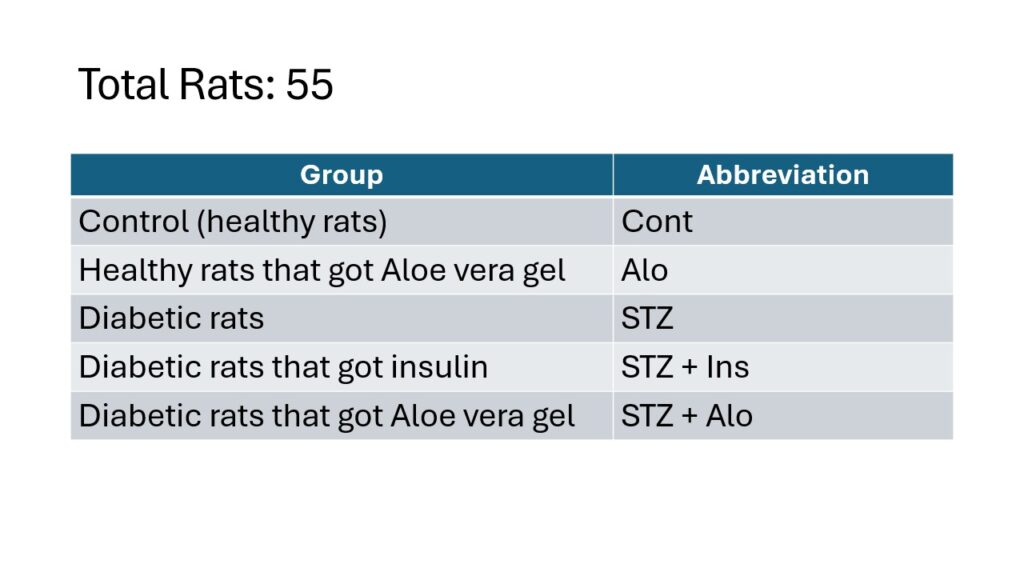
The first question to answer is how did they come up with diabetic rats? Well, that is where the STZ comes in. This is Streptozotocin, a chemical used to cause diabetes in lab animals. To make rats diabetic, a single injection of STZ was given. Three days later, their blood sugar was tested. Rats with high blood sugar were confirmed diabetic before the experiment began.
The next question is What is insulin? Insulin is naturally occurring in mammals and is a hormone, produced in the pancreas, that keeps blood sugars normal. Of course, because some of the groups included diabetic rats that meant that insulin was no longer naturally generated, so insulin was employed through injection as a part of the research strategy.
How was the aloe gel given? It was given by mouth via a small tube.
All these treatments were given for 8 weeks and then their behaviors were tested. They looked at things like
- Anxiety or depression-like behaviors
- Movement and exploring habits
- Memory performance
At the end of the research project, they also studied a part of the brain called the hippocampus, which helps with memory and emotions, to see if it was damaged. These STZ-diabetic rats are a common model for studying how diabetes affects the brain, especially the hippocampus, which is a main target of damage from high blood sugar and oxidative stress. Plus, this study, has a dual focus. One on diabetes and the other on memory concerns like dementia and Alzheimer’s Disease.
Let’s now take a look at the results: We start first with body weight and blood sugar.
The control group of rats, the healthy ones, weighed in at 203 grams and by the end of the study were at 277 grams. This is considered healthy and normal. The rats that received only Aloe vera gel (Acemannan) displayed similar weight gain from 200 grams to 293 grams. The STZ rats (now remember these are the diabetic rats) started at 202 grams but lost weight by the end of the study at 172 grams. This represents a typical weight-loss pattern of uncontrolled diabetes. Then the diabetic group that was given insulin started at 207 grams and gained up to 270 grams, showing normal weight gain. Then the diabetic group that was also given aloe vera gel (Acemannan) weighed in at 206 and in similiar fashion to the control group gained weight up to 248 grams. Both insulin and aloe gel made a significant contribution to healthy weight gain in diabetic rats.
Then these statistics focused on Blood Glucose. The control group, the healthy rats, had a 115 mg/dl at the beginning of the study and a reading of 109 at end of the study. This is virtually the same at the end as it was the beginning with but little variation. The same was true with the rats given aloe gel alone. From 113 to 107. The diabetic rats started at 438 mg/dl, which confirms their diabetic diagnosis but by the end of the study it was even worse at 541. The diabetic rats that were given insulin started at 519, but ended at 204, giving indication that the blood sugar had moved toward normal. The diabetic rats given aloe gel
Started at 536 but their blood sugar readings had moved downward to 255. though not as low as insulin (519 → 204), it’s still a strong improvement.
It’s important to point out
Aloe gel alone did not lower blood sugar in non-diabetic rats, confirming that it does not serve as a general hypoglycemic agent (in other words, it does not lower blood sugar levels in anyone, regardless of whether they have diabetes or not) but, instead, it contributes to the restoration of balance in diabetic conditions. This is more evidence we have gleaned in our other studies, that aloe gel and its active component Acemannan does not deliver toxicity or make negative impacts.
Then they tested the rats in what is called the Passive Avoidance Test (PAT).
The Passive Avoidance Test is a behavioral experiment used in animal studies (commonly with rats or mice) to evaluate learning and memory, especially memory retention. It’s a common test for assessing cognitive function in neurological or diabetic models.
The test setup typically includes a two-compartment box:
- One side is lighted (where the rat starts).
- The other side is dark (rats naturally prefer dark spaces).
The rat is placed in the lighted compartment.
- When it moves into the dark compartment (as expected by instinct), it receives a mild foot shock.
- This creates an association between the dark compartment and the accompanying discomfort.
Then usually 24 hours later:
- The rat is placed in the lighted compartment again.
- The time it takes to enter the dark compartment (called latency) is recorded.
- A longer latency indicates that the rat remembers the unpleasant experience and avoids the dark area—meaning better memory retention.
This bar graph shows the number of attempts (trials to acquisition) it took for the rats to get the message that stepping into a dark area means it will be shocked. All the mice on average got the message after one to two attempts.

This bar graph is a record that measures how long the rat waits before stepping into the dark compartment during the memory test.
A higher percentage means the rat waited longer—this shows it remembered the shock and was hesitant to go into the dark area.
A lower percentage means the rat forgot and went into the dark space more quickly. Of interest here is both the alo and the Diabetic rat with alo displayed the highest memory percentages. But the diabetic rats displayed evidence that they had forgotten about the dark room and the accompanying discomfort.
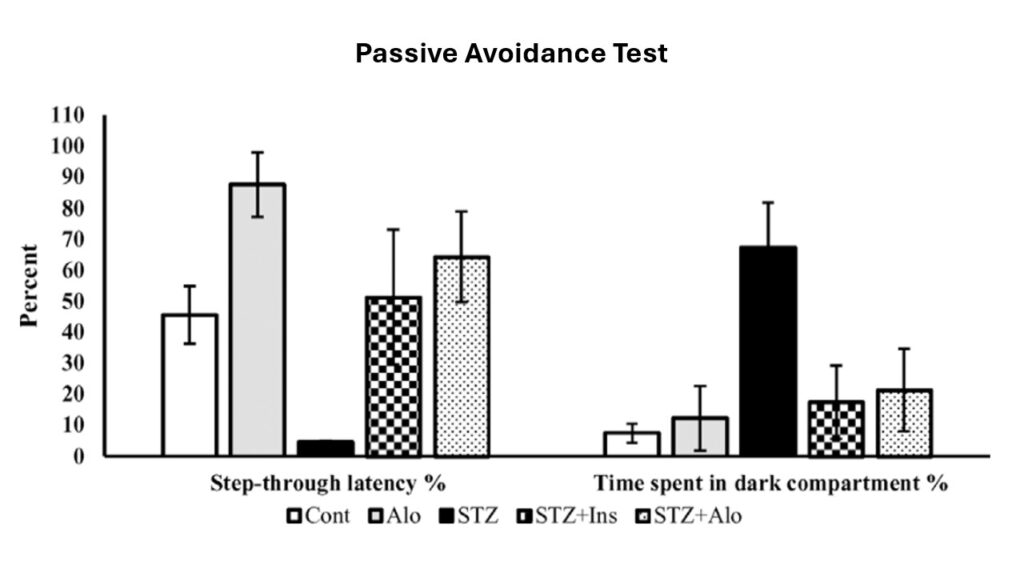
The bar graph next to it measures how long the rat stayed in the dark area during the test.
A higher percentage means the rat forgot about the shock and stayed in the dark area too long. In this case, it was the diabetic rats.
A lower percentage means the rat remembered it was a bad place and quickly left or avoided it. Both the alo and STZ+ Alo displayed the relatively high memory retention.
Another test was employed, the FST. This is the Forced Swim Test. It was used to measure depression-like behavior in the rats. This test looks at how long a rat stays still (immobile) when placed in water with no way to escape. More time spent not moving is seen as a sign of depression-like behavior.
The diabetic rats (STZ group) spent more time immobile than the other groups, suggesting they showed more signs of depression.
When diabetic rats were treated with Aloe vera gel (Acemannan), their immobility time significantly decreased, meaning they were more active and showed less depression-like behavior. The scientists considered this diabetic/aloe group statistically significant, and the diabetic/insulin group not so much.
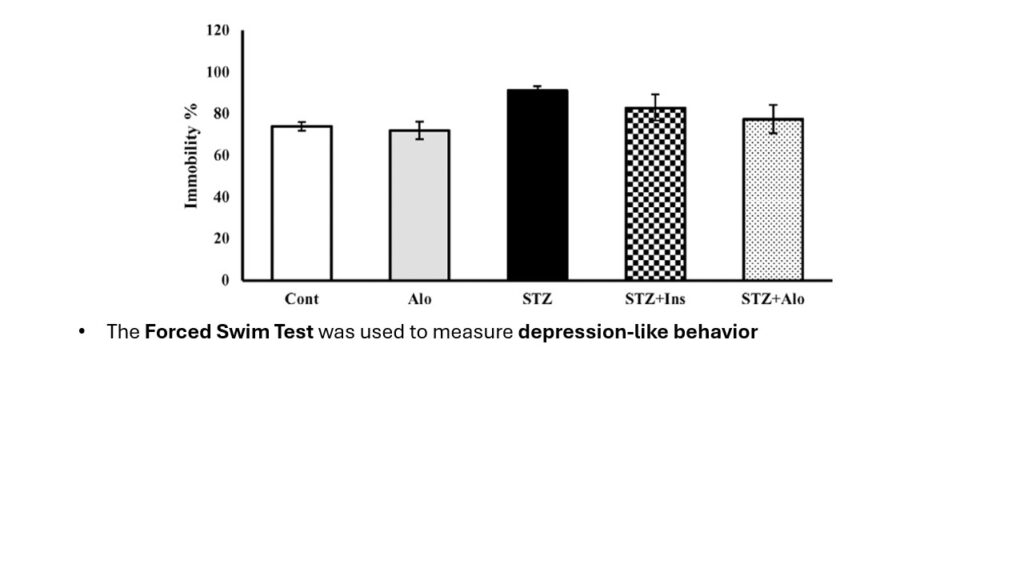
The Tail Pinch Test (TPT) is used to trigger stress-related behavior in rats. It helps researchers see how the animals react to a mild, short-term stressor.
In this study, researchers measured how often the rats showed a specific reaction to stress called NFMA (non-focused motor activity—like random or restless movement).
The diabetic rats (STZ group) had much higher levels of this stress-related behavior than the other groups, showing they were more affected by stress.
But when diabetic rats were treated with Aloe vera gel or insulin, these stress behaviors significantly decreased, alo a little more so. That means both treatments helped the diabetic rats handle stress more normally, in comparison to the healthy control rats.
Okay, all that represents the behavioral testing, so now at the end of the 8 weeks they engaged in biochemical results.
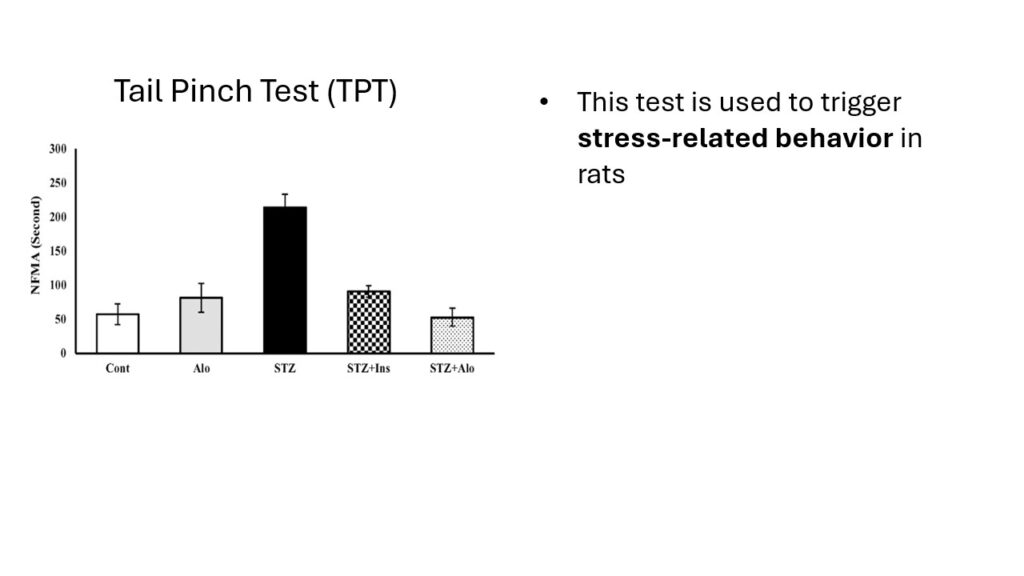
Figure 6A – MDA levels (a marker of cell damage):
- MDA (Malondialdehyde) is a chemical formed when cells are damaged by oxidative stress.
- Diabetic rats (STZ group) had high MDA levels, showing more brain cell damage.
- Rats treated with Aloe vera gel or insulin had lower MDA levels, meaning less damage.
- → Conclusion: Aloe vera and insulin both helped protect the brain from diabetes-related cell damage
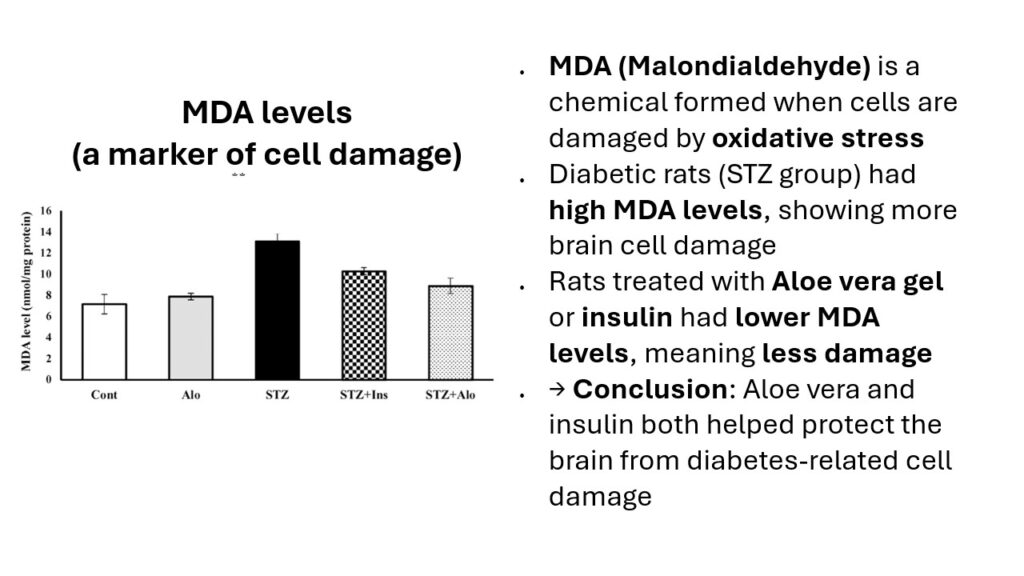
Figure 6B – GPX activity:
- GPX (Glutathione Peroxidase) is one of the body’s antioxidants. And the scientists determined that the GPX was not strongly affected enough by either diabetes or aloe treatment to take note, though they did provide this graph as a record.
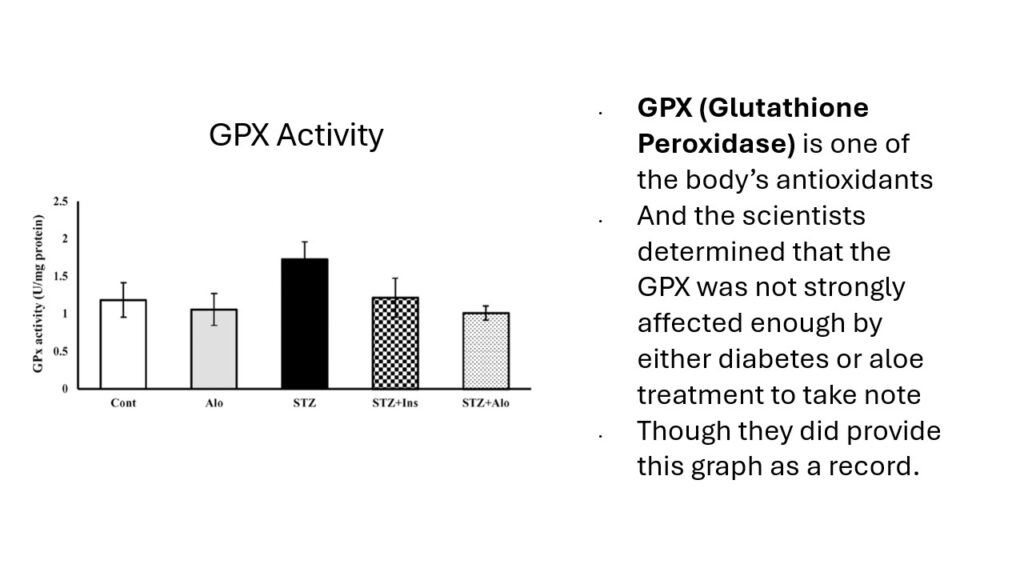
Figure 6C – SOD activity:
- SOD (Superoxide Dismutase) breaks down harmful oxygen radicals.
- Diabetic rats had lower SOD activity—meaning they were less protected.
- Aloe vera treatment greatly boosted SOD activity, more than insulin; more than the control group.
- → Conclusion: Aloe vera inner leaf gel helped the brain fight oxidative stress by increasing SOD levels.
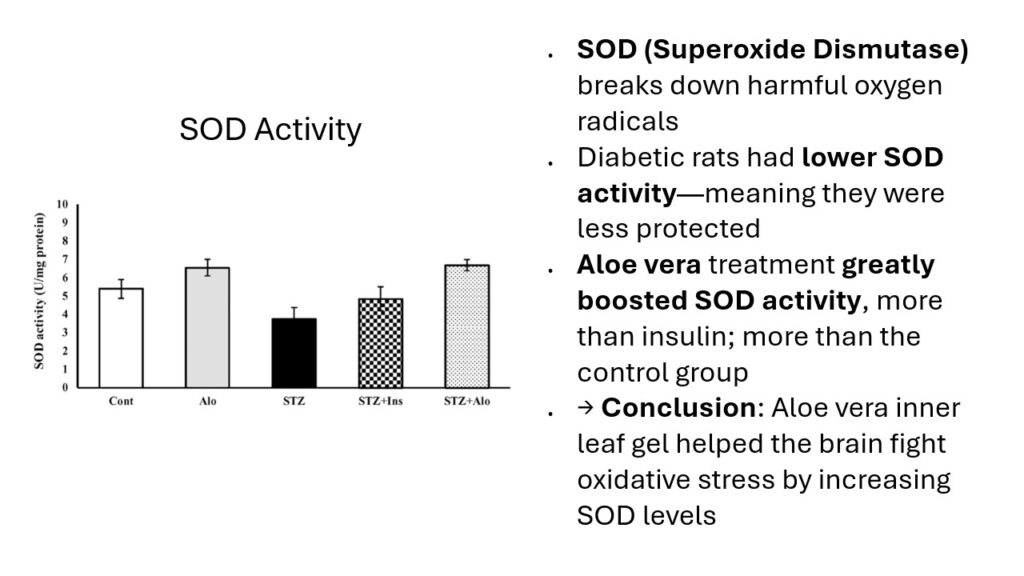
Figure 6D – CAT activity:
- CAT (Catalase) is another antioxidant enzyme that helps remove harmful hydrogen peroxide.
- CAT activity was somewhat reduced in diabetic rats, though not significantly.
- Aloe vera treatment caused a strong increase in CAT activity. Insulin was about the same.
- → Conclusion: Aloe vera helped restore CAT activity, another way it reduced brain stress.
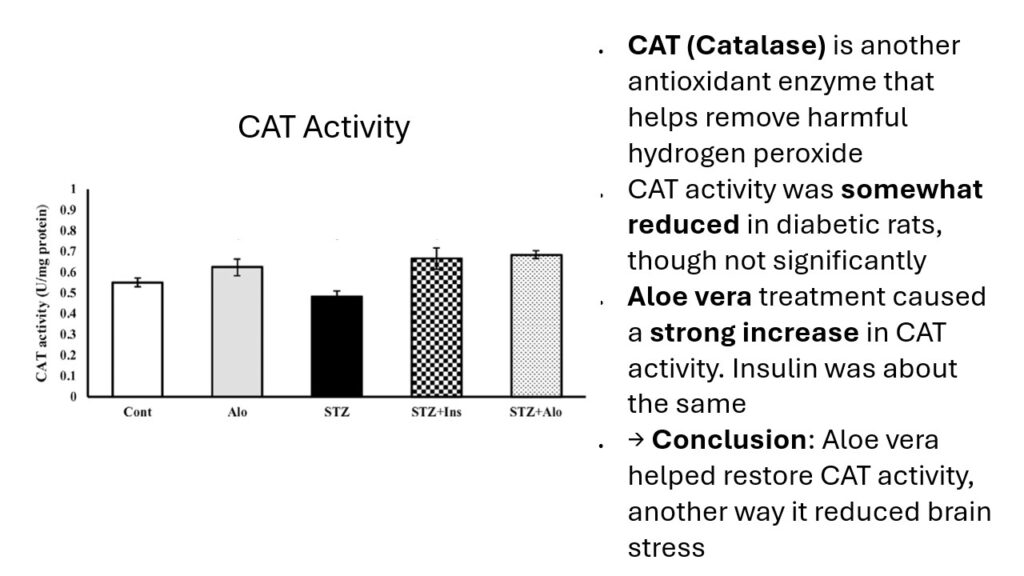
This study shows that Aloe vera gelj, and its active ingredient Acemannan, helped reduce the negative effects of diabetes on the behavior of and in the brain of rats.
- Diabetic rats had memory problems, signs of anxiety and depression, and brain cell damage.
- After 8 weeks of treatment with Aloe vera gel, the rats:
- Showed lower blood sugar
- Acted more normally (less anxious, less depressed)
- Had better memory
- Showed less brain cell damage under the microscope
Aloe gel worked by improving the brain’s antioxidant defenses, which protect against harmful molecules that can build up during diabetes. It also helped prevent changes in behavior and brain function that are usually caused by long-term high blood sugar.
So, Aloe vera gel, and its active components, like Acemannan, may be a useful natural support for protecting the brain in people (or animals) with diabetes. It’s not a replacement for insulin, but it may help reduce stress on the brain and support mental health and memory.
I hope you will always be careful to maintain good works to meet urgent needs and become heroes to your generation.
0 Comments